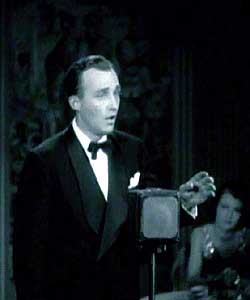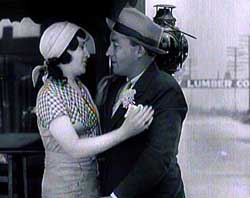 Dream House (1932) had the reissue title Crooner's Holday, & was one of four short films later re-edited by Bud Pollard into a phony biography of Bing's career, The Road to Hollywood (1947). The other short films reworked into the strained biopick were I Surrender Dear (1931), One More Chance (1931), & Billboard Girl (1932).
Dream House (1932) had the reissue title Crooner's Holday, & was one of four short films later re-edited by Bud Pollard into a phony biography of Bing's career, The Road to Hollywood (1947). The other short films reworked into the strained biopick were I Surrender Dear (1931), One More Chance (1931), & Billboard Girl (1932).
Bing Crosby sings "Take My Sugar to Tea" on his way to ask Betty (Ann Christy) to get married. Betty's on her way to Hollywood & he's got to hurry to catch her. At the train, they exchange promises of marriage, & Betty leaves with engangement ring on finger.
Betty's mother (Catherine Clare Ward) doesn't want her beautiful daughter marrying a mere plumber. From California the mother does what she can to sabotage the engagement.
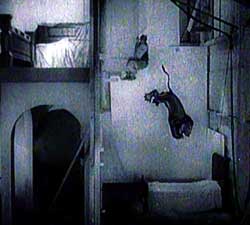 After a few months, third-rate roles have been about the height of Betty's success in the movies. Her mother wants to control the young woman's career & arranges for her to be involved with the "right" man. After a few months, third-rate roles have been about the height of Betty's success in the movies. Her mother wants to control the young woman's career & arranges for her to be involved with the "right" man.
Bing arrives in Hollywood to find out what on earth happened between Betty & himself, but he's kept off the film lot. He has several slapstick moments trying to reach Betty, including an unfortunately racist blackface routine that goes on & on.
While on the set of an Arabian desert film, one of the "extras," Bing in disguise, bursts into the song, "It Must Be True (Beside a Shady Nook)." Hell breaks loose, all leading to lovers' reunion & Betty's decision to stop being an actress & return to Missouri.
But before that debatably happy ending, there's an awesomely absurd chase scene with a movie lion, leading to Bing being trapped inside an upright piano with the lion just before the piano goes skittering down a staircase.
On the way home to Missouri Bing sings "I Have Built a Dream House" to Betty. In all, this two-reel comedy is silly, none of it even slightly credible, but it really only exists for the tunes, & those are fair to good.
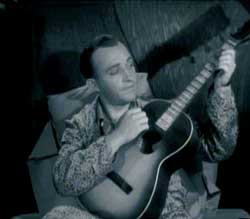 Another of Bing's early Max Sennet comedies is Blue of the Night (1933), a company not noted for sophistication so much as for being first to get such stars as Bing onto the silver screen.
Another of Bing's early Max Sennet comedies is Blue of the Night (1933), a company not noted for sophistication so much as for being first to get such stars as Bing onto the silver screen.
He sings a "My Silent Love" under the opening credits, & "Auf Wiedersehen, My Dear" sung on his radio program is particularly well done.
Co-starring Babe Kane, Bing meets her on a train & she pretends she's engaged to a famous radio crooner, not knowing she's talking to him.
He manages to keep his identity from her even while singing "Every Time My Heart Beats" -- from his sleeper bearth claiming he has a radio. Though she's wacky & makes stuff up, he's kind of fallen for her.
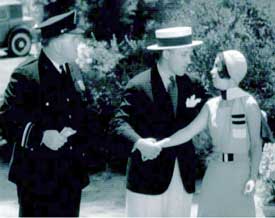 The comic "villain," really more of an idioit, is Franklin Pangborn as Gilbert. He's a rival for Babe's hand, or thinks he is at least. The comic "villain," really more of an idioit, is Franklin Pangborn as Gilbert. He's a rival for Babe's hand, or thinks he is at least.
When Bing reveals he's the famous crooner, Gilbert believes is convinced this guy is just posing as a radio personality.
He's so sure Bing's a fake that he bets his fancy Cadillac roadster against Bing's five dollars that he's not Bing.
If he's really Bing & not a fake, then he should be able to sing. So he sings the film's title number:
"Where the blue of the night meets the gold of the day/ Someone waits for me./ And the gold of her hair/ Crowns the blue of her eyes/ Like a halo, tenderly."
It's wicked that Bing does take the car, not satisfied to have just gotten the girl. In several of Bing's early short films, he can get the girl only by making lots of other characters miserable. The humor here is not particularly effective effective. Only its two-reel brevity & the songs themselves make Blue of the Night tolerable.
copyright © by Paghat the Ratgirl
|
